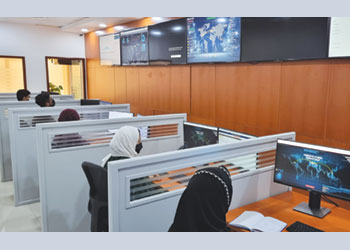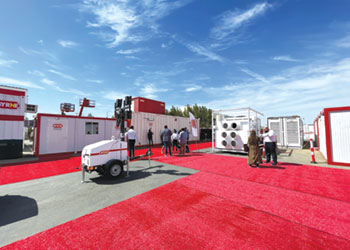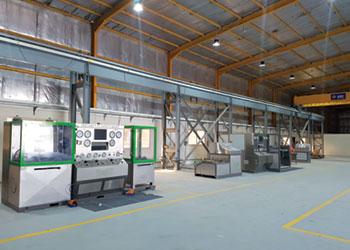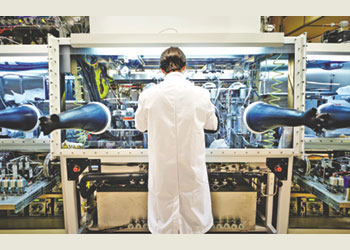
 Dr Abdulwahab Al-Sadoun, Secretary General, GPCA, speaks at the 3rd GPCA Leaders Forum
Dr Abdulwahab Al-Sadoun, Secretary General, GPCA, speaks at the 3rd GPCA Leaders Forum
There is a need for exploring new technologies, such as CCUS, renewable energy, blue and green hydrogen and circular economy as some of the trends that promise great opportunity for the chemical industry in the region
The chemical industry is showing an increased awareness of its role as an essential enabler in the global transition to a low carbon economy. However, the current temperature trajectory of the industry stands at 4 deg C, much higher than the globally sought-after 1.5 deg C temperature goal.
The industry is the third largest source of emissions in the industrial sector, contributing 14 per cent of total industrial CO2 emissions, according to a new white paper developed by GPCA and dss+.
With demand for petrochemicals expected to grow, and the Middle East being home to some of the largest industry companies, in such a scenario, the petrochemical and chemical industries have an important role to play in supporting the circular economy.
This includes developing products that are recyclable, reducing waste and emissions, and exploring new ways to use waste streams as raw materials.
The aforementioned paper highlights that the industry is central to the achievement of net-zero ambitions, as its products could contribute to emissions reduction in other industries.
Dietmar Siersdorfer, Managing Director Middle East and UAE, Siemens Energy, says the industry must work through alliances, innovation, and existing technology to reduce carbon emissions, especially in hard-to-abate industries.
Hard-to-abate industries include steel, cement, petrochemicals, and together, these industries are responsible for nearly 30 per cent of global greenhouse gases.
Petrochemical and chemical companies would redesign plants to utilise residual process gas along with hydrogen from these industries.
THE OPPORTUNITIES IN NET-ZERO
Senior global and regional industrial leaders suggest net-zero provides clear opportunities for the sector.
Hilal Kharusi, Chief Executive, Commercial & Downstream, OQ, stressed on the importance of embracing the energy transition and looking for ways to make operations more sustainable.
"This means there is a need for exploring new technologies, such as carbon capture, utilisation and storage (CCUS), investing in renewable energy sources, and innovation," he said at the Gulf Petrochemicals and Chemicals Association (GPCA) Leaders Forum.
Renewable energy investment, carbon capture, blue and green hydrogen and the influence of circular economy are just some of the trends that promise great opportunity for the chemical industry in the region.
Additionally, CCUS prospects also provide great promise to the chemical sector, as it could help cut down global emissions by 38 per cent by 2060.
As R&D takes shape in the region, CCUS could become an important lever to decarbonisation and a tool to diversifying the chemical sector's income streams.
Similarly, investments in blue and green hydrogen also offer great potential for the chemical industry, with the UAE, Kuwait and Oman having national hydrogen strategies and pilot projects. Saudi Arabia for instance is aiming for generating 4 MT per annum by 2035.
The chemical industry could capitalise on this growth by using hydrogen for industrial heating or as a low-carbon feedstock.
The chemical industry could capitalise on this growth by using hydrogen for industrial heating or as a low-carbon feedstock.
Additionally, circular economy — and its associated design principles, which promote waste reduction and circular design — and waste management and recycling are seeing support and investment from countries like Saudi Arabia and the UAE.
Tapping into a circular economy mindset and utilizing waste from other industries can provide the chemical industry with alternative feedstocks, lower-carbon products, and synthetic fuels.
CHANGE TOWARD LOWER-CARBON WAYS
The current trend toward lower-emission operations in the GCC is an opportunity for the chemical industry to update its approach and become a leading force in the region and globally.
Oliver Gawad, Director, Middle East, Sustainability & Industrial Strategy, dss, outlines five building blocks as the first steps on the journey towards decarbonisation.
• Companies need to understand their own greenhouse gas (GHG) emissions sources, which includes scope 3emissions. Such a baselining exercise will help identify emissions hotspots and form short-term priorities and longer-term goals.
• Science-based targets should be set in relation to reducing emissions. Understanding emission reduction potential and committing to a science-based target (SBT) will ensure that a company is aligned with the global 1.5 deg C target, and that climate risks are mitigated.
Globally, 32 companies have committed to SBTs but there is no company from the GCC on that list.
• Developing a net-zero roadmap is the next step on a decarbonisation journey. It will help to focus efforts on major identified decarbonisation levers with carbon offset measures, identify low hanging fruits that can be implemented, and identify tasks that require more time and investment.
• A net-zero finance mobilisation plan is essential to finance the transition, and budget scenarios for the short, medium and long term should be considered to ensure sufficient resourcing.
CONCLUSION
There is growing realisation in the industry, particularly in the GCC, that an ambitious step-up is needed in order to address climate change. While initial changes have been taking place, more scale is required to achieve the required impact.
Finally, it is important that organisations plan for an orchestrated approach and assess their in-house capabilities and plan for change, as a successful implementation will require the whole organization’s involvement.
The four steps mentioned above can only be implemented effectively and sustainably with skilled personnel on board, capability development and change management. Assessing internal capabilities and plugging skills and knowledge gaps is essential to enabling action.
Finally, true net-zero transformation cannot be achieved in isolation without the involvement of external stakeholders such as policy makers, suppliers, customers’ downstream and financial institutes. Collaboration will be a key lever for success.





















































































